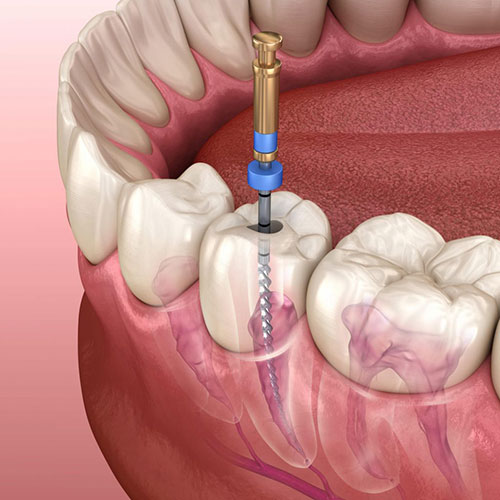

If you've been told that you need a root canal, don't panic. Root canals are one of the most common dental procedures performed today and they're nothing to be afraid of. In fact, having a root canal is often no more uncomfortable than getting a filling. At My Family Dental in Mokena, IL, we use state-of-the-art technology and techniques to make your root canal experience as comfortable and stress-free as possible.
But what exactly is a root canal? And why might you need one? Let's start by understanding the basics of this important dental procedure.
A root canal is a treatment used to repair and save a badly damaged or infected tooth. The procedure involves removing the damaged tissue, called the pulp, from the center of the tooth. Once the pulp is removed, the space inside the hard layers of the tooth is cleaned and sealed.
The pulp can become inflamed or infected due to deep decay, repeated dental procedures on a tooth, or a crack or chip in the tooth. If left untreated, the inflammation or infection can cause an abscess, which can lead to serious complications such as bone loss around the tip of the root (apical periodontitis).
Root canals have a high success rate and can relieve your pain and save your tooth. In fact, with proper care, a tooth that has had a root canal can last a lifetime. However, it's important to note that after a root canal, the tooth becomes more brittle and prone to fractures. To restore its strength and function, a permanent restoration such as a crown is usually necessary.
Here are some signs that you might need a root canal:
However, not all root canals are obvious. Sometimes, a tooth may need a root canal even if you're not experiencing any symptoms. That's why regular dental check-ups and x-rays are so important.
A root canal procedure typically involves the following steps:
The entire procedure usually takes between 30 minutes to an hour, depending on the complexity of the root canals and the tooth's location in your mouth. In some cases, more than one visit may be necessary.
After your root canal, it's crucial to restore the tooth with a permanent crown or other restoration to protect it from further damage and ensure its full functionality. Without proper restoration, the tooth is at a higher risk of breaking or becoming reinfected. Your dentist will discuss the best restoration options for your specific needs.
After your root canal, it's important to take good care of your tooth. Here are some tips:
With proper care, a tooth that has had a root canal can last a lifetime. However, it's important to remember that even with a root canal, the outer surface of the tooth is still vulnerable to decay, cracks, and other damage. That's why it's so important to continue with good oral hygiene practices and regular dental check-ups.
At My Family Dental in Mokena, IL, we're committed to providing our patients with the highest quality dental care. If you have any questions or concerns about root canals or any other aspect of your dental health, please don't hesitate to contact us. We're here to help!
A root canal procedure is the best way to save a tooth that has been damaged by decay or injury and preserve your natural smile. The alternative is an extraction and treatment to replace the tooth. While at times a tooth is non-restorable and an extraction is the only option, when possible, it’s best to try and save your natural tooth. With proper care, a tooth with root canal therapy can serve your smile well for many years to come.
Despite lingering myths from before the age of modern dental anesthesia and technology, having a root canal procedure today is as routine and comfortable as visiting the dentist for a filling. While the procedure is performed under local anesthesia with your tooth completely numbed, we can also discuss options in dental sedation.
Whether the symptoms of a dental infection subside after a course of antibiotics, a draining abscess provides you with some temporary pain relief, or a tooth with radiographic evidence of pathology has not yet developed symptoms, it’s essential, before an infection worsens or occurs, to have a root canal procedure performed. In this way, the tooth can be disinfected, filled, and sealed to protect your health and avoid further problems.
If you have sustained a dental injury, have a toothache, jaw pain, swelling, or are experiencing any other unusual and uncomfortable oral symptoms, contact our office immediately for care. Dental problems that have not been evaluated and treated can significantly worsen, producing more severe damage and consequences for the involved teeth, your oral health, and even your overall wellbeing. Once you get in touch with our office, our friendly and compassionate office team will get you in for care at your earliest convenience.
While some root canal procedures can be completed in one visit, others may involve 2 or 3 appointments. How long it takes depends on various factors, including active infection, the number of canals in the tooth, and the tooth’s location or anatomy.
With a success rate that exceeds 95%, root canal therapy remains the most effective procedure to save a tooth in which the inner vital tissues have been damaged. However, as with all healthcare procedures, there are a small percentage of cases where the teeth become symptomatic a second time. The good news is that many of these teeth can still be saved with root canal retreatment or a minor surgical procedure known as an apicoectomy.
The best ways to maintain a tooth with root canal therapy are to get the proper restoration required to rebuild and protect the tooth, maintain proper oral hygiene, and schedule appointments for routine dental checkups and care.
Saving a tooth with root canal therapy is a wise investment that, in the long run, is typically less costly and invasive than having the tooth extracted and replaced with a fixed bridge or implant. As far as the exact cost of care, it can vary depending on which tooth is being treated. Many dental insurance plans provide coverage for root canal therapy. At the office of My Family Dental, we do our best to optimize your dental benefits and minimize your out-of-pocket expenses. Our staff will answer all your questions about the cost of care and discuss all your payment options.
At the office of My Family Dental, we use the latest technology and most effective methods of care to provide precise and gentle care. Our reputation for excellence is based upon a consistent record of achieving successful treatment outcomes while providing prompt, stress-free, and convenient treatment for every type of dental need.
